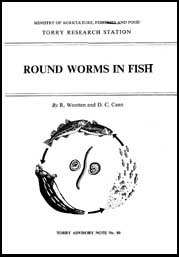Contents Index

Accompanying Notes
Table of Contents
By R. Wootten and D. C. Cann
MINISTRY OF AGRICULTURE, FISHERIES AND FOOD
TORRY RESEARCH STATION
TORRY ADVISORY NOTE No. 80
Crown copyright material is reproduced with the permission of the Controller of Her Majesty's Stationery Office.
This electronic document has been scanned using optical character recognition (OCR) software and careful manual recorrection. Even if the quality of digitalisation is high, the FAO declines all responsibility for any discrepancies that may exist between the present document and its original printed version.
Gives background information on the nature, life history, occurrence and human health hazards of the predominant round worm parasites in fish, the nematodes Phocanema decipiens (cod worm) and Anisakis simplex (herring worm). Describes how to reduce the infestation in fish used as food, and detection by candling. Advises on the conditions required to kill the nematodes, and comments on standards and specifications. Gives information useful for dispelling common misunderstandings of the problem and for dealing with complaints from consumers. This Note is relevant to Notes 5, 27, 33, 43, 57, 66, 67, 75, 81 and 82.
It is important to note that different countries have different national regulations, or give non-mandatory guidance, for the control of nematodes as a human health hazard in fish products, and importers and exporters should be aware of the requirements of current legislation. Within the European Union, products that are lightly cured, such as marinades and smoked fish, and intended to be eaten to be eaten without further cooking, must be frozen 'at a temperature of not more than -20°C in all parts of the product for not less than 24 hours', in addition to the curing process intended. In good practice, this should be interpreted as quick freezing to a minimum of -20°C at the thermal centre, followed by storage at or below -20°C for at least 24 h.
(FAO in partnership with Support unit for International Fisheries and Aquatic Research, SIFAR, 2001).
Introduction
What are parasites?
How do round worms get into
fish?
Are round worms dangerous?
Can infestation of fish
be reduced?
How serious is
the problem of worms in fish?
Contents Index